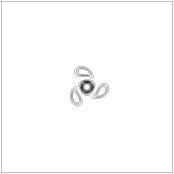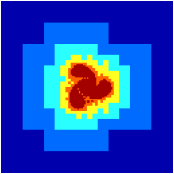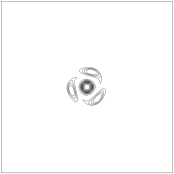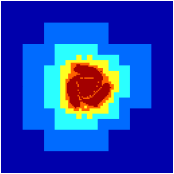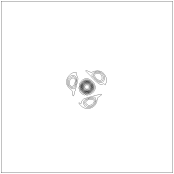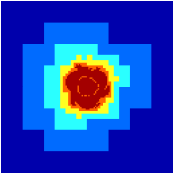


4.3 PASS:
Convergence for the three-way vortex merging problem
-
Author
- Stéphane Popinet
- Command
- sh merging.sh merging.gfs
- Version
- 0.6.4
- Required files
- merging.gfs (view) (download)
merging.sh levels.gfv vorticity.gfv sim.err.ref simc.err.ref
- Running time
- 4 minutes 47 seconds
Another of the test cases presented in Popinet [31],
initially used by Almgren et al. [1], this convergence
test illustrates the second-order accuracy of Gerris when refinement
is placed appropriately, either through static refinement or dynamic
adaptive refinement.
Four vortices are placed in the unit-square, centred at (0,0),
(0.09,0), (−0.045,0.045√3) and (−0.045, −0.045√3)
and of strengths −150, 50, 50, 50 respectively. The profile of
each vortex centred around (xi,yi) is
where ri=√(x−xi)2+(y−yi)2. To initialise the velocity
field, we use this vorticity as the source term in the Poisson
equation for the streamfunction ψ
Each component of the velocity field is then calculated from the
streamfunction. No-flow boundary conditions are used on the four sides
of the domain and the simulations are ran to t=0.25 using a CFL of
0.9.
Two different discretisations are used, each time with up to L
levels of refinement: a grid using static refinement in concentric
circles of decreasing radius and a grid using dynamic adaptive
refinement. The “circle” grid is constructed by starting from a
uniform grid with four levels of refinement and by successively adding
one level to all the cells contained within circles centred on the
origin and of radii:
-
L=6: 0.25, 0.15
- L=7: 0.25, 0.2, 0.15
- L=8: 0.25, 0.2, 0.175, 0.15
- L=9: 0.25, 0.2, 0.175, 0.1625, 0.15
For the dynamically refined grid, the vorticity-based criterion is
applied at every timestep with a threshold τ=4×10−3. As
we do not have an analytical solution for this problem, Richardson
extrapolation is used.
Figure 66 illustrates the evolution of the vorticity
and of the adaptively refined grid for L=8. The most refined level
closely follows the three outer vortices as they orbit the central
one. Far from the vortices, a very coarse mesh is used (l=3). One
may note a few isolated patches of refinement scattered at the
periphery of the outer vortices. They are due to the numerical noise
added to the vorticity by the interpolation procedure necessary to
fill in velocity values for newly created cells. This could be
improved by using higher-order interpolants.
Table 4 summarises the results obtained for the
first twelve calculations. For fine enough grids close to
second-order convergence is obtained for both norms and for the two
discretisations used. The norms of the error on the various grids
are also comparable for a given resolution.
| Table 4: Errors and convergence orders in the x-component of the
velocity for the four-way vortex merging problem. The reference
solution values are given in blue. |
| Domain | L2 |
| | L=6 | O2 | L=7 | O2 | L=8 |
| Circle | 2.63e-02 | 1.32 | 1.06e-02 | 1.98 | 2.69e-03 |
| | 2.63e-02 | 1.32 | 1.06e-02 | 1.98 | 2.69e-03 |
| Adaptive | 2.56e-02 | 1.25 | 1.08e-02 | 1.93 | 2.82e-03 |
| | 2.56e-02 | 1.25 | 1.08e-02 | 1.93 | 2.82e-03 |
| Domain | L∞ |
| | L=6 | O∞ | L=7 | O∞ | L=8 |
| Circle | 4.56e-01 | 1.28 | 1.88e-01 | 1.95 | 4.87e-02 |
| | 4.56e-01 | 1.28 | 1.88e-01 | 1.95 | 4.87e-02 |
| Adaptive | 4.46e-01 | 1.19 | 1.96e-01 | 1.98 | 4.94e-02 |
| | 4.46e-01 | 1.19 | 1.96e-01 | 1.98 | 4.94e-02 |
| Figure 66: Contour plots of vorticity (left) and adaptive grids used
(right) for the four-way vortex merging calculation. |



